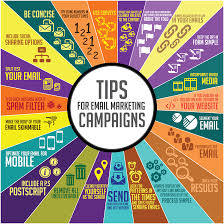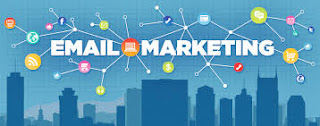Email Marketing Tips For Small Businesses
 Email marketing is a great way
to reach your customers where they are without spending a lot of money.
But it's a big responsibility, too—people don't give their email
addresses to just anyone. Thinking about starting a company newsletter?
Here are some tips to keep in mind.
Email marketing is a great way
to reach your customers where they are without spending a lot of money.
But it's a big responsibility, too—people don't give their email
addresses to just anyone. Thinking about starting a company newsletter?
Here are some tips to keep in mind.
Make it easy to subscribe. Post a signup form on
your homepage, blog, Facebook page, and wherever else your customers and
fans are already active. You might want to collect names and birthdays
(for a special offer or gift) or invite readers to join groups, but
don't go crazy with the required fields. A too-long subscribe form might
scare people off.
Tell subscribers what to expect. Whether you plan to
send company updates, letters from the president, e-commerce sales,
daily deals, or weekly tips, it's important to tell your readers what to
expect and how often to expect it. Give them as much information as
possible on your signup form, so they can decide whether they want to be
on the list or not. Make Money Online
Send a welcome email. It's always smart to remind
people why they're on your list and reassure them that good things are
in store. You might even send new subscribers a special offer or
exclusive content, as your way of thanking them for their loyalty.
Design your newsletter to fit your brand. Your email
campaigns should match your brand's look and feel. If you're using a
template, you might want to customize it to include your company's
colors and logo in the header. If your emails are consistent with the
rest of your company's content, then readers will feel more familiar
from the start.
Make it scannable. Your subscribers are busy people who get a lot of email, so it's safe to assume you don't
have their undivided attention. Instead of one long block, break up
your content into short paragraphs. Include subheadings and images to
guide readers through your email and make it easier to scan, and add a
teaser to the top of your newsletter to tell subscribers what's in
store. If you're sending a long article, consider inserting a "read
more" link so people can get to the rest when it's convenient for them.
Your subject line should be to-the-point and easy to digest, too. You
might even want to a/b test subject lines to see which ones perform
best.
Send people content they want. Email newsletter
services offer features like groups and segmentation to help you make
your content relevant to the people reading it. If you're sending
different emails for different groups (for example, a nonprofit might
send separate emails to volunteers, donors, and the board of directors),  then you can ask people to check a box to join a particular group on
your signup form. Segmentation allows you to target certain subscribers
on your list without assigning them to group. If your store is having a
sale, then you could send a campaign only to people near a particular
zip code, because subscribers who live in other parts of the world don't
need to know about it. You can also segment by activity, email clients,
e-commerce data, and more. Sending relevant content will keep your
readers engaged, and engaged readers look forward to your newsletter and
share it with friends.
then you can ask people to check a box to join a particular group on
your signup form. Segmentation allows you to target certain subscribers
on your list without assigning them to group. If your store is having a
sale, then you could send a campaign only to people near a particular
zip code, because subscribers who live in other parts of the world don't
need to know about it. You can also segment by activity, email clients,
e-commerce data, and more. Sending relevant content will keep your
readers engaged, and engaged readers look forward to your newsletter and
share it with friends.
 then you can ask people to check a box to join a particular group on
your signup form. Segmentation allows you to target certain subscribers
on your list without assigning them to group. If your store is having a
sale, then you could send a campaign only to people near a particular
zip code, because subscribers who live in other parts of the world don't
need to know about it. You can also segment by activity, email clients,
e-commerce data, and more. Sending relevant content will keep your
readers engaged, and engaged readers look forward to your newsletter and
share it with friends.
then you can ask people to check a box to join a particular group on
your signup form. Segmentation allows you to target certain subscribers
on your list without assigning them to group. If your store is having a
sale, then you could send a campaign only to people near a particular
zip code, because subscribers who live in other parts of the world don't
need to know about it. You can also segment by activity, email clients,
e-commerce data, and more. Sending relevant content will keep your
readers engaged, and engaged readers look forward to your newsletter and
share it with friends.
Keep a publishing calendar. A regular newsletter is a
commitment. If you go several months without sending anything, then
your subscribers will forget about you, and they'll be more likely to
delete the next email, or worse, mark it as spam. Make time to plan,
write, design, and send your newsletters regularly.
 Edit. Even editors need editors. When you're working
on your publishing calendar, leave plenty of time for the editing and
revision process. Once you send a campaign, it goes straight to the
inbox, and you can't go back and update it. Newsletters contain
meaningful content, and sloppy ones reflect poorly on the companies who
send them. Grammar and style are just as important for email as they are
for websites and blogs.
Edit. Even editors need editors. When you're working
on your publishing calendar, leave plenty of time for the editing and
revision process. Once you send a campaign, it goes straight to the
inbox, and you can't go back and update it. Newsletters contain
meaningful content, and sloppy ones reflect poorly on the companies who
send them. Grammar and style are just as important for email as they are
for websites and blogs.
Test. Different email clients and mobile devices
display emails differently. Send test emails to colleagues, or use a
testing program to make sure your emails are going to look good on
screens big and small. Testing reveals design mistakes before it's too
late, and testing programs can predict whether or not a campaign will
get caught in a spam filter. You could even set up accounts with a few
different email services for easy testing. Avoid sending one big image
as a campaign, and cover your bases with a plain-text option for every
email.
Think about mobile. If a campaign doesn't show up on
mobile devices, it's not going to perform very well. Everything you
send should be mobile-friendly. Check out ReturnPath's "Email in Motion" infographic for
some data that might affect the way you design your emails. One of the
highlights: According to the study, 63 percent of Americans and 41
percent of Europeans would either close or delete an email that's not
optimized for mobile. Might be time to start using a responsive
template.
 Know your spam rules. A lot of innocent people send spam because they didn't know any better. Read up on the CAN-SPAM act to
avoid any trouble. Put simply, you're allowed to send bulk email only
to people who specifically asked to be on your mailing list. If you
collected email addresses for a lunch giveaway or an event invitation,
then you don't have permission to send marketing emails unless you made
that clear at signup. Include an obvious unsubscribe link in every
email, and don't forget to remind subscribers how they got on your list
in the first place.
Know your spam rules. A lot of innocent people send spam because they didn't know any better. Read up on the CAN-SPAM act to
avoid any trouble. Put simply, you're allowed to send bulk email only
to people who specifically asked to be on your mailing list. If you
collected email addresses for a lunch giveaway or an event invitation,
then you don't have permission to send marketing emails unless you made
that clear at signup. Include an obvious unsubscribe link in every
email, and don't forget to remind subscribers how they got on your list
in the first place.Collected by # http://www.copyblogger.com


.jpeg)




.jpeg)
No comments